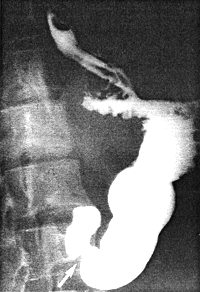



Go to chapter: 1 | 2 | 3 | 4 | 5 | 6 | 7 | 8 | 9 | 10 | 11 | 12 | 13 | 14 | 15 | 16 | 17 | 18 | 19 | 20 | 21 | 22 | 23 | 24 | 25 | 26 | 27 | 28 | 29 | 30 | 31 | 32 | 33 | 34 | 35 | 36 | 37 | 38 | 39
Chapter 12 (page 47)
Chapter 12
The Pylorus at Rest: Open or Closed?
In considering the mechanism of the pylorus it is of importance to determine, first of all,
if the aperture is open or closed at rest. By “at rest” is meant conditions
pertaining after an overnight fast, in which the stomach is empty except for normally
occurring intraluminal gas, swallowed saliva and gastric secretions; it denotes the motor
quiescent phase of the interdigestive myo-electric complex, with absence of
radiologically discernible motor activity.
As indicated in Chap. 15, a number of authors held the view that the canine and human
pylorus was surrounded by a narrow zone of raised pressure which was tonically
contracted "at rest", closing the aperture; with the advent of an “antral”
peristaltic wave the aperture relaxed (Brink et al. l965; Isenberg and Csendes l972;
Fisher and Cohen l973). Other authors found or inferred that the pylorus was patent
under fasting conditions, that it was not surrounded by a zone of elevated basal pressure,
and that it did not act antagonistically to oncoming peristaltic waves (Atkinson et al.
l957; Andersson and Grossman l965; Kaye et al. l976; McShane et al. l980; White et
al. l98l; Gaffney et al. l987).
It can be assumed that an open pyloric aperture will allow the passage of liquids, while a
closed pylorus will not. For this reason a fluid barium suspension has been used to
determine the patency, or otherwise, of the aperture.
A total of 100 adult, ambulatory outpatients were examined radiologically after an
overnight fast. All had been referred for routine radiographic studies because of vague
abdominal symptoms; patients with definite clinical symptoms and signs such as
recurrent epigastric pain, weight loss, vomiting, haematemesis, melaena or a palpable
mass, were excluded from the study.
Patients were examined in the erect and supine positions, each being asked to swallow
three mouthfuls (45 ml) of a barium suspension in quick succession. The
viscosity of the suspension was approximately four times that of water, the specific
gravity was 2.004 and the consistency that of thick soup. These features ensured a
fluidity which was less than that of water, but probably slightly more than that of chyme.
The state of the pylorus was determined by TV fluoroscopy and radiography, not more
than one or two “spot” films being exposed (size of radiation field 14.5
x ll.5 cm). As soon as this had been done, more barium was swallowed
(usually with the addition of effervescent salts)), and the conventional barium
examination, for which the patient had been referred, was completed. If this revealed an
organic lesion, the case was also excluded. In this group of 100 patients, in other words,
the upper gastrointestinal tract was considered to be normal clinically as well as
radiologically.
Ethical Considerations.
In 52 patients the screening time due to the procedure varied from 5 to 15 seconds; in 48
patients it was longer, varying from 25 to 60 seconds. (In all the technique of
intermittent screening was used). The anterior and posterior skin doses of x-
radiation were measured and found to be negligible. As a small field (14.5 x ll.5
cm) limited to the upper abdomen was involved, it was felt that the extra radiation,
received as a result of the procedure, could be discounted.
In 52 of the 100 patients the swallowed, liquid barium suspension passed rapidly down
the oesophagus, traversed the stomach and flowed through the pyloric aperture in one
smooth movement, without any delay or hold-up at the pylorus. This occurred in the
absence of visible motor movements in the stomach. In many cases the head of barium
was in the duodenum while the “tail end” was still in the oesophagus
(Fig. 12.1). In all cases the normal, deep annular indentation of the pyloric
ring between the stomach and duodenum became clearly visible as soon as the barium
had traversed the aperture (Fig. 11.1). The part of the stomach on the
immediate oral side of the ring (the pyloric sphincteric cylinder) was
expanded without being unduly distended.
The width of the barium column in the pyloric aperture, between the lips of the ring,
indicated the diameter of the aperture. It was measured on the films and varied from a
minimum of 4.0mm to a maximum of 10.0 mm between subjects, the diameter in the
majority being in the 5.0 to 10.0 mm range. (Owing to technical factors minor
geometrical magnification occurs during radiographic filming, and the true measurements
will be approximately four-fifths of those measured on the films).
In 48 patients there was some delay or hold-up at the ring; in the majority the delay
varied from approximately 40 to 90 seconds; in a few it lasted for 2 or 3 minutes. The
following are representative cases:
 |
Fig. 12.1.
Rapid swallowing in fasting stomach. Barium suspension traverses pyloric
aperture, which is patent (arrow). “Tail end” of barium still in
oesophagus. Absence of gastric motor movements
|
Previous Page | Table of Contents | Next Page
© Copyright PLiG 1998







